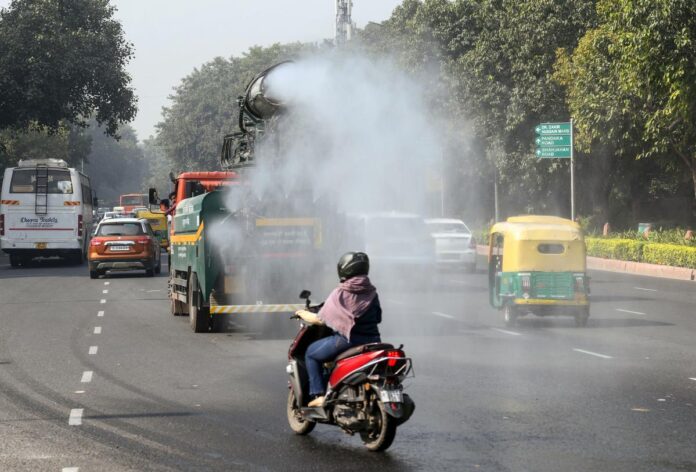Delhi’s Air Quality Declines as AQI Hits “Very Poor” Levels
As winter approaches, Delhi has once again slipped into the infamous “very poor” air quality category, with smog thickening the city’s skies. On Sunday, the city’s 24-hour average Air Quality Index (AQI) reached a worrying 356, categorizing it as “very poor.” Key locations reported particularly high AQI levels, with IGI Airport at 324, ITO at 367, India Gate at 374, and DU North Campus reaching 370. The degrading air quality has created health concerns for residents, who are increasingly vulnerable to respiratory issues and other health complications.
What Is Causing Delhi’s Worsening Air Quality?
Delhi’s deteriorating air quality during the winter months is a result of various factors that come together to trap pollutants in the atmosphere. Here’s a look at the major contributors:
- Vehicular Emissions
Delhi’s heavy traffic congestion significantly contributes to air pollution. Emissions from vehicles are high in nitrogen dioxide (NO₂) and particulate matter, both of which worsen air quality, particularly when they become trapped close to the ground due to temperature inversion during winter. - Industrial Emissions
Delhi and its surrounding regions are home to many industries that release pollutants into the air, including sulfur dioxide (SO₂) and particulate matter. Industrial activities add to the cumulative load of airborne pollutants that exacerbate the smog situation. - Stubble Burning
Farmers in neighboring states like Punjab and Haryana often burn crop stubble during October and November to clear fields for new crops. Smoke from these fires drifts over to Delhi, causing a spike in PM2.5 and PM10 particles, which pose significant health risks when inhaled. - Construction Dust
With constant construction and infrastructure projects across the National Capital Region (NCR), dust from construction activities remains a persistent issue, adding more particulate matter to the already saturated air. - Weather Conditions
As winter sets in, temperature inversion becomes common, trapping pollutants close to the ground. The lack of strong winds means these pollutants stay in the air for extended periods, forming a dense layer of smog over the city.
Health Implications of Poor Air Quality
The shift to “very poor” air quality levels is a serious concern for Delhi’s residents. Prolonged exposure to high AQI levels, particularly those containing fine particulate matter, can lead to numerous health issues:
- Respiratory Problems
Pollutants like PM2.5 can penetrate deep into the lungs, leading to respiratory issues like bronchitis, asthma, and other chronic lung diseases. Those with pre-existing respiratory conditions are especially vulnerable. - Cardiovascular Risks
Studies have linked poor air quality to an increased risk of heart attacks, high blood pressure, and other cardiovascular diseases. The inhalation of pollutants causes oxidative stress and inflammation, which can affect heart health over time. - Eye and Skin Irritation
High pollution levels can irritate the eyes, nose, and throat, leading to discomfort and even infections. Similarly, exposure to pollutants can lead to skin problems such as rashes and dryness. - Mental Health Effects
Recent studies have highlighted a link between poor air quality and cognitive health, with evidence suggesting that high pollution levels may contribute to anxiety, depression, and even cognitive decline.
Government Initiatives and Public Responsibility
In response to the worsening air quality, the Delhi government and the Central Pollution Control Board (CPCB) have implemented measures to mitigate pollution levels. Initiatives include restrictions on construction activities, promoting the use of public transport, and implementing odd-even vehicle schemes during severe pollution periods. However, individual actions also play a crucial role in reducing pollution levels.
- Use Public Transport
By choosing public transportation over private vehicles, residents can contribute to lowering vehicle emissions, which is one of the leading causes of pollution in Delhi. - Avoid Outdoor Activities
During times of poor air quality, especially for vulnerable groups like children and the elderly, it’s advisable to limit outdoor activities to minimize exposure to pollutants. - Support Green Initiatives
Supporting initiatives that increase green cover in urban areas can help absorb pollutants, providing a natural way to improve air quality over time. - Stay Informed
Keeping track of daily AQI levels can help individuals plan their activities to minimize exposure on days with particularly high pollution levels.
Conclusion: Time for Long-Term Solutions
While temporary measures may bring slight relief, Delhi’s recurring air quality issues call for long-term strategies. From enforcing stricter pollution control measures to encouraging sustainable farming practices that eliminate the need for stubble burning, a collaborative approach between government, industry, and the public is essential. Only with sustained efforts can Delhi hope to breathe easier and avoid the severe health impacts that accompany prolonged exposure to poor air quality.

